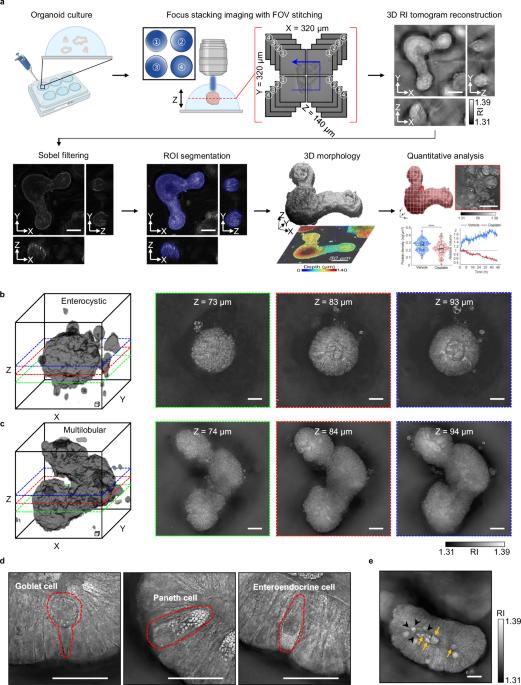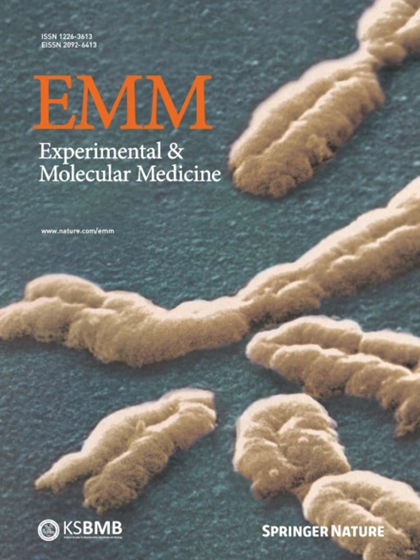通过低相干全图对未标记的活体小肠有机体进行长期三维高分辨率成像。
IF 9.5
2区 医学
Q1 BIOCHEMISTRY & MOLECULAR BIOLOGY
引用次数: 0
摘要
类器官是器官的微型体外版本,在研究人类疾病和阐明其潜在机制方面具有巨大潜力。活体成像技术在类器官研究中起着至关重要的作用,有助于阐明类器官的复杂结构和动态生物现象。然而,主要由于三维(3D)结构中固有的样品处理和光学散射的复杂性,对原生有机体进行非标记的高分辨率活体成像具有挑战性。此外,传统的成像方法无法捕捉到有机体生长的实时动态过程。在本研究中,我们引入了低相干全息成像技术,作为一种先进的、无标记的定量成像方式,旨在克服三维有机体长期实时成像的若干技术障碍。我们以亚细胞分辨率捕捉了小鼠小肠器官组织内的高分辨率形态细节和动态活动,证明了低相干全图成像的功效。此外,我们的方法还有助于区分有活力和无活力的类器官,大大提高了其在类器官研究中的实用性。这一进展凸显了活体成像在类器官研究中的关键作用,有助于更全面地了解这些复杂的系统。本文章由计算机程序翻译,如有差异,请以英文原文为准。

Long-term three-dimensional high-resolution imaging of live unlabeled small intestinal organoids via low-coherence holotomography
Organoids, which are miniature in vitro versions of organs, possess significant potential for studying human diseases and elucidating their underlying mechanisms. Live imaging techniques play a crucial role in organoid research and contribute to elucidating the complex structure and dynamic biological phenomena of organoids. However, live, unlabeled high-resolution imaging of native organoids is challenging, primarily owing to the complexities of sample handling and optical scattering inherent in three-dimensional (3D) structures. Additionally, conventional imaging methods fail to capture the real-time dynamic processes of growing organoids. In this study, we introduce low-coherence holotomography as an advanced, label-free, quantitative imaging modality designed to overcome several technical obstacles for long-term live imaging of 3D organoids. We demonstrate the efficacy of low-coherence holotomography by capturing high-resolution morphological details and dynamic activities within mouse small intestinal organoids at subcellular resolution. Moreover, our approach facilitates the distinction between viable and nonviable organoids, significantly enhancing its utility in organoid-based research. This advancement underscores the critical role of live imaging in organoid studies, offering a more comprehensive understanding of these complex systems. Organoids, miniature 3D structures that imitate real organs, are grown in labs to study human biology and diseases. However, their complex structures and behaviors are hard to understand due to imaging technology limitations. In this study, researchers used a method called low-coherence holotomography to study mouse small intestinal organoids. This method let them observe organoids’ growth and drug responses in real-time, without altering their natural state. They conducted an experiment involving over 120 hours of continuous imaging, providing new insights into organoid development, cell dynamics, and drug responses. The study shows that low-coherence HT can reveal detailed 3D structures and changes within organoids, such as cell division and death, with high resolution. This research could revolutionize drug development and testing and provide new insights into human biology and diseases. This summary was initially drafted using artificial intelligence, then revised and fact-checked by the author.
求助全文
通过发布文献求助,成功后即可免费获取论文全文。
去求助
来源期刊

Experimental and Molecular Medicine
医学-生化与分子生物学
CiteScore
19.50
自引率
0.80%
发文量
166
审稿时长
3 months
期刊介绍:
Experimental & Molecular Medicine (EMM) stands as Korea's pioneering biochemistry journal, established in 1964 and rejuvenated in 1996 as an Open Access, fully peer-reviewed international journal. Dedicated to advancing translational research and showcasing recent breakthroughs in the biomedical realm, EMM invites submissions encompassing genetic, molecular, and cellular studies of human physiology and diseases. Emphasizing the correlation between experimental and translational research and enhanced clinical benefits, the journal actively encourages contributions employing specific molecular tools. Welcoming studies that bridge basic discoveries with clinical relevance, alongside articles demonstrating clear in vivo significance and novelty, Experimental & Molecular Medicine proudly serves as an open-access, online-only repository of cutting-edge medical research.
 求助内容:
求助内容: 应助结果提醒方式:
应助结果提醒方式:


